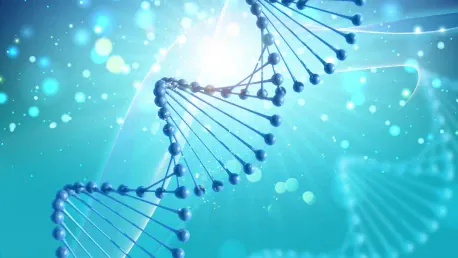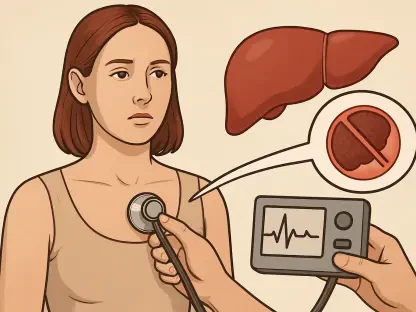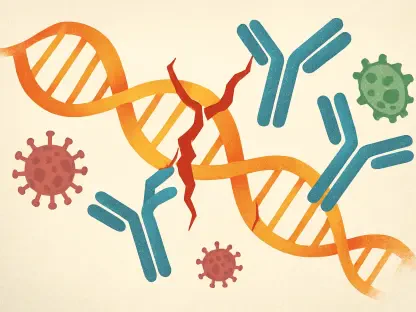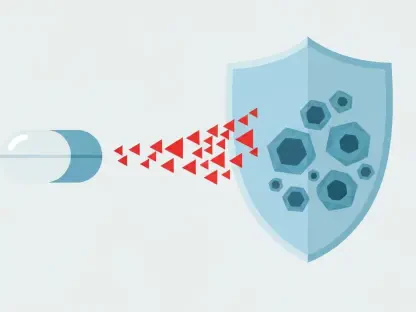Cancer scientists at the University of Chicago and the University of California, San Francisco (UCSF) have made groundbreaking discoveries about the genetic changes caused by DNA collisions in cancer. Their research, published in “Nature Cancer” in November 2024, reveals how gene mutations can lead to DNA errors resulting in large tandem duplications (TDs). These TDs are caused by collisions between transcription and DNA replication processes. Understanding the DNA damage leading to TDs opens new pathways for targeted cancer treatments, especially for cancers with these genetic alterations.
The Role of DNA in Cellular Processes
DNA as the Master Blueprint
DNA serves as the master blueprint for all genetic information, ensuring consistency and error-free replication as cells divide. This accuracy is maintained by DNA repair mechanisms that correct errors occurring during replication. When these repair systems fail, mutations occur, leading to genomic instability—a hallmark of cancer. Despite the recognized importance of these repair failures, understanding their causes has been a major challenge in cancer research. Investigating these causes is crucial to unveiling new therapeutic strategies that can effectively target the origins of genomic instability.
The double-helix structure of DNA is a marvel of molecular biology, featuring each strand as both a template for replication and a source of instructions for protein synthesis during transcription. These dual roles demand precision and coordination in cellular processes. While transcription and replication usually proceed concurrently without interference, collisions between these processes, which are known as transcription and replication collisions (TRCs), can sometimes occur. These collisions result in cellular stress and disrupt these vital processes, potentially leading to mutations and further contributing to genomic instability in human cancers.
Transcription and Replication Collisions (TRCs)
In the landscape of cancer research, the precise role of transcription and replication collisions (TRCs) in driving genomic instability has not been fully understood until recently. TRCs are becoming a focal point for understanding how genetic mutations emerge and how they can be mitigated. Scientists have long recognized that genetic mutations are a primary driver of cancer, and TRCs provide a new lens through which these mutations can be studied. By examining the interplay between DNA replication and transcription, researchers are gaining novel insights into the molecular mechanisms at play.
The importance of recognizing TRCs lies in their potential to disrupt the synchronization of cellular processes, leading to structural changes in DNA that could foster the development of cancer. The growing interest in TRCs has paved the way for researchers to delve deeper into how these collisions translate to genetic damage, thereby uncovering specific types of DNA alterations like large tandem duplications. By shedding light on the mechanisms through which TRCs contribute to cancer, this research sets the stage for developing innovative treatments that directly address these collisions.
Investigating TRCs in Cancer
Research Collaboration and Methodology
The research team, spearheaded by Lixing Yang, PhD, Assistant Professor in the Ben May Department of Cancer Research at the University of Chicago, collaborated with UCSF researchers to identify tumors with high TRC levels. Their mission was to explore potential treatments that target replication, transcription, and DNA damage repair mechanisms. To achieve this, they conducted comprehensive genome sequencing and analyzed thousands of tumor samples, seeking to uncover various structural variations such as nucleotide deletions, duplications, and translocations. These endeavors aimed to establish a solid foundation for new therapeutic strategies.
A significant aspect of their methodology involved the identification of tumors displaying unique combinations of structural changes. By understanding these unique combinations, the researchers could discern patterns and subsets formed by multiple mechanisms generating these variations. This comprehensive approach not only included the genetic analysis but also took into account external factors like tobacco smoking in lung cancer and UV exposure in melanoma, which were identified as distinct contributors to mutational changes. Such factors were incorporated into their study to provide a holistic understanding of the causes of genetic mutations in cancers.
External Factors and Mutation Signatures
The study’s innovative approach included mathematical decomposition to discern specific mutation signatures, which revealed underlying mechanisms or contributing factors for mutation subsets. This technique involved deconstructing complex genomic data into simplified forms, making it possible to identify distinct mutation signatures correlated with particular external influences. For instance, identifying mutation patterns linked to tobacco usage or UV exposure allowed researchers to understand how external environment and lifestyle factors contributed to cancer development.
Harnessing data from 6,193 whole-genome-sequenced tumors, the researchers meticulously focused on the roles played by TRCs in driving genomic instability. By identifying a unique signature of structural variations arising from collisions through dosage imbalance—a change in DNA copy number at the junctions where DNA strands merge—researchers uncovered novel information about the cellular processes. This imbalance resulted when additional copies of DNA strands were erroneously appended to other regions, causing structural changes in the genome. Understanding these changes was crucial for identifying mechanisms leading to repeated DNA patterns, also known as tandem duplications.
Discovering the Impact of Large Tandem Duplications
Structural Variations and Dosage Imbalance
The comprehensive study highlighted the prevalence and implications of large tandem duplications (TDs) in various cancers. By delving into structural variations through genome sequencing, the researchers discovered a significant association between TRCs and dosage imbalances. When extra copies of DNA strands are improperly incorporated into other regions, these structural changes create repetitive DNA patterns. These patterns, known as tandem duplications, result from the erroneous alignment of DNA strands near their original sequences. Such structural variations are crucial in understanding how genetic mutations drive cancer progression.
The research underscores that large TDs are especially common in certain cancer types, including cancers of the upper gastrointestinal tract, prostate cancer, and female-related cancers such as breast and ovarian cancer. These large TDs have been found to correlate strongly with poor patient survival rates, emphasizing their clinical significance. Notably, they are also associated with mutations in specific genes such as TP53, CDK12, and SPOP, which play critical roles in cell cycle regulation and DNA repair. The study’s findings provided concrete evidence linking these mutations to the occurrence of large tandem duplications, thereby offering new insights into the genetic basis of certain cancers.
Prevalence in Specific Cancers
The study definitively characterized the role of collisions in driving mutations like those seen in CDK12, which lead to extensive tandem duplications. By pinpointing these genetic alterations, researchers offered a clearer understanding of how certain cancers develop and progress. Furthermore, the identification of mutation signatures allowed for the classification of cancers based on their genetic profiles, facilitating the development of personalized treatment approaches. Recognizing the prevalence of large TDs in specific cancers has enabled the medical community to tailor more effective treatment plans according to individual genetic makeups.
The correlation between large TDs and poor patient survival further highlights the urgency of developing targeted treatment options for these cancer types. This study demonstrated that understanding the genetic landscape of tumors can greatly enhance therapeutic strategies, offering hope for patients with aggressive cancers. The association between specific gene mutations and TDs provides potential biomarkers for early detection and monitoring, helping clinicians predict cancer behavior and response to treatments. This understanding marks a significant step forward in precision medicine, where identifying patient-specific genetic alterations is key to successful cancer management.
Potential Therapeutic Strategies
Increased Sensitivity to Specific Drugs
One of the most promising outcomes of this research was the discovery of the increased sensitivity of cancers harboring large tandem duplications to specific drugs. Notably, inhibitors like WEE1, CHK1, and ATR have shown potential in treating cancers characterized by high levels of TDs. These drugs target critical aspects of the cell cycle and DNA damage response mechanisms, making them effective against cancers with pronounced genetic alterations. The identification of these inhibitors presents new therapeutic possibilities that could improve the prognosis and treatment outcomes for patients with difficult-to-treat cancers.
The sensitivity of these cancers to specific inhibitors underscores the importance of a targeted treatment approach. By leveraging drugs that specifically address the genetic weaknesses of tumors with large TDs, researchers aim to enhance the efficacy of treatment modalities. This personalized approach is aligned with the increasing emphasis on precision medicine, which tailors therapy to the individual characteristics of each patient’s cancer. The study’s findings provide a strong rationale for clinical trials to validate the efficacy of these inhibitors and potentially incorporate them into standard cancer treatment protocols.
Support and Collaboration
The successful execution of this research was made possible through substantial support from various institutions and collaborative efforts among scientists. Key contributors to the project included the National Institutes of Health, the University of Chicago, University of Chicago Medicine Comprehensive Cancer Center, Prostate Cancer Foundation, Department of Defense, Benioff Initiative for Prostate Cancer Research at UCSF, and the Martha and Bruce Atwater Breast Cancer Research Program at UCSF. This collaborative framework allowed for a robust exchange of ideas, resources, and expertise, driving the research forward.
The interdisciplinary collaboration extended beyond institutional boundaries, involving researchers with diverse expertise from both universities. Such extensive teamwork was crucial in addressing the complex challenges of understanding and targeting genetic mutations in cancer. This collective effort highlights the importance of pooling resources and knowledge to tackle pressing medical issues, ultimately aiming to translate research findings into tangible benefits for cancer patients globally. The study exemplifies how collaborative research can lead to innovative solutions and advancements in the field of oncology.
Implications for Cancer Treatment
Genetic Underpinnings and Tailored Therapies
The article emphasizes the significance of understanding the genetic underpinnings of cancer in the development of tailored therapies. By elucidating the role of DNA collisions in genetic changes, particularly through large tandem duplications, the researchers provided a vital piece to the puzzle of cancer biology. This knowledge has the potential to revolutionize treatment approaches by enabling precision in targeting the specific genetic aberrations unique to each cancer subtype. The insights gained from this study underscore the importance of personalized medicine in effectively combating cancer.
Through meticulous genome analysis and the identification of structural variation signatures, the researchers opened new avenues for cancer therapeutics. Future directions in cancer research will likely focus on harnessing these insights to design targeted treatments that address the unique genetic profiles of individual tumors. By bridging the gap between genetic research and clinical applications, the study paves the way for advancements in cancer treatment, enhancing the ability to develop more effective and less toxic therapies.
Future Directions in Cancer Research
Researchers at the University of Chicago and the University of California, San Francisco (UCSF) have made significant findings regarding genetic alterations resulting from DNA collisions in cancer cells. This study, featured in “Nature Cancer” in November 2024, details how gene mutations can create DNA errors that lead to substantial tandem duplications (TDs). These duplications arise due to collisions between transcription and DNA replication processes within the cell. By comprehending the DNA damage that results in TDs, the scientists have paved the way for developing more precise cancer treatments. This breakthrough is particularly crucial for types of cancer exhibiting these specific genetic abnormalities, offering hope for more effective and targeted therapeutic approaches. These discoveries are a considerable step forward in the ongoing effort to understand and combat the genetic complexities of cancer, potentially transforming the treatment landscape for patients with such genetic profiles.









